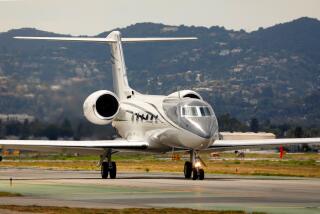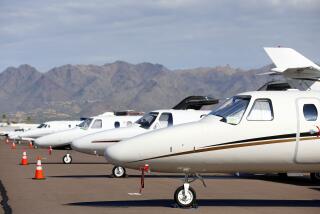Executive Travel : Can’t Afford a Corporate Jet? Share One
- Share via
Corporate jets have long been a source of turbulence for companies, which have often found them difficult to justify to cost-conscious shareholders.
The perception that corporate jets are a luxury or an ego expense has lingered even though many firms say they save money and build productivity in the long run.
Now a growing number of firms are finding a way to afford their own jets by leasing or chartering them or joining increasingly popular time-share programs.
Last month, for example, New Jersey-based Executive Jet Aviation, one of the nation’s largest jet time-sharing companies, announced a $150-million order for 25 Cessna Citation V Ultras and an option for 25 more. The order is the largest ever placed for business jets, according to Cessna.
Executive Jet already operates 37 business jets and has another five on order. Its sales have doubled every year since 1991..
“The charter business is also showing strong growth,” said Jane McBride, chief executive of Flight Time International, an air charter company based in Brookline, Mass.
The growth of Executive Jet and firms like it reflects the changing pattern of aircraft ownership. Corporate ownership of jets is down but use is up, said Pete West, vice president of government affairs for the National Business Aircraft Assn.
“General aviation has been in a depressed market, but the one element that has continued to grow is the use of business aircraft,” said West. “If you look at the diversity of ways you can purchase or use cars, the same is now true of corporate jets.”
The reason for the market’s growth is that while companies want to use private jets because of their efficiency, the price is still too high, said Kevin Russell, senior vice president of Executive Jet. “Owning a corporate jet is prohibitive for most people.” For example, it costs between $2.5 million and $3 million, not including aircraft maintenance and flight department management costs, to own a Citation V Ultra, which seats seven passengers and has a range of 1,500 miles. The cost of a Hawker 1000, a nine-passenger jet with a range of 3,200 miles, is about $13 million.
By time-sharing, however, companies get the use of a corporate jet on demand for a fraction of the cost. Under Executive Jet’s NetJet time-sharing program, for example, a company would pay $330,000 for a one-eighth share interest in a particular Citation jet. In addition, each owner pays a maintenance fee of $5,765 a month and $1,090 for each hour of occupied flight time.
The company pays only for time its employees are actually using the plane, not the time it takes to fly the plane to pick up the client. Each owner is allotted 100 hours of occupied flight time. Because Executive Jet has a fleet of jets, it is able to guarantee that an aircraft will be available on four hours’ notice anywhere in the country, 24 hours a day.
So far, about 80% of Executive Jet’s time-share participants are companies that have not previously owned aircraft. The balance are those that have either cut back their fleets or are not expanding them and are using time-sharing to increase their capacity.
The market for business jets has stalled in recent years. Sales of business aircraft peaked in 1981 with 389 sold, said Shelly Snyder, spokeswoman for the General Aircraft Manufacturers Assn. in Washington. In 1993, there were 198 delivered, she said.
For the first six months of 1994, manufacturers shipped 101 jets, compared to 98 for the same period a year ago.
To combat slow sales, the General Aviation Manufacturers Assn. in conjunction with the National Business Aircraft Assn. has mounted a “No Plane, No Gain” advocacy program to tout the merits of using corporate jets.
For example, according to a study conducted by the accounting firm Arthur Andersen & Co., jets are used by 46 of the 50 firms on Fortune magazine’s honor roll, which ranks the top firms in terms of return to investors.
There is a popular misconception that only the largest companies use business jets, but many of the those on the list are smaller, more entrepreneurial companies, Snyder said.
Corporate jets are most useful for companies that have manufacturing or other facilities in smaller cities and rural areas far from commercial hubs. Companies also find the planes are useful when executives need to get to several locations in one day.
There are far more airports in the United States that can handle general aviation aircraft such as business jets than those that can handle commercial jetliners, West said. “That means business jets are able to provide direct links to rural and outlying areas outside America’s regional economic hubs,” he said.
More to Read
Sign up for The Wild
We’ll help you find the best places to hike, bike and run, as well as the perfect silent spots for meditation and yoga.
You may occasionally receive promotional content from the Los Angeles Times.






